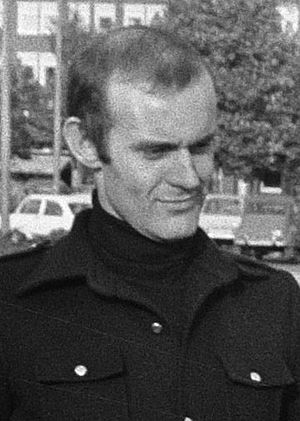Tom Gilbey (designer) facts for kids
Quick facts for kids
Tom Gilbey
|
|
|---|---|

Tom Gilbey in 1969
|
|
| Born | 19 May 1938 New Cross, London, England
|
| Died | 24 May 2017 (aged 79) |
| Occupation | Fashion designer |
Tom Gilbey (born May 19, 1938 – died May 24, 2017) was a British fashion designer. He was famous for his stylish clothes made on Savile Row in the 1960s. His designs are so important that they are kept in museums. You can see his work at the Fashion Museum in Bath. His clothes are also part of the collections at the Victoria & Albert Museum and the Museum of London.
Contents
Early Life of Tom Gilbey
Tom Gilbey grew up in New Cross, London. He came from a family that worked hard. He finished school when he was fifteen years old.
Tom Gilbey's Fashion Career
Tom Gilbey started working in the fashion world in the 1960s. This was a very exciting time for fashion. He once said that the 1960s were full of "intense brilliance."
Gilbey learned how to make clothes from scratch. He started in a small workshop in South London. There, he learned all about cutting fabric and tailoring. He also went to Shoreditch Clothing College. Tom believed it was important for designers to understand how clothes are actually made. He said, "It's all right doing sketches... but you've got to sit down and get your form and get your line." This meant understanding how clothes fit and look on a person.
When Gilbey joined the fashion scene around Savile Row in 1968, it was a very traditional place. He described it as "a gentleman's world." He had his shop on Sackville Street.
Gilbey was part of a new group of designers changing menswear. He mentioned other designers like Tommy Nutter and Michael Fish. These designers brought fresh ideas to the classic Savile Row style.
Gilbey's Design Ideas
Tom Gilbey had clear ideas about how clothes should be. In 1967, he said that people needed clothes they could "put on and forget about." These clothes still needed to look good and help them do their jobs. He believed clothes should be easy to move in and simple in design.
In 1968, Gilbey shared more about his ideas. He called it "The Tom Gilbey Concept." He thought clothes should be light and easy to mix and match. A man's basic clothes should work for many different parts of his life. They should take him from work to fun without needing to change.
Famous Designs and Reviews
Gilbey's first collection for men in May 1968 received great reviews. One newspaper called him "one of Britain's more avant garde designers." They said he was a pioneer of the polo-neck shirt, the cat suit, and the zip-up jacket.
- A suit he designed in 1968 is at the Victoria & Albert Museum. It shows how informal clothes became in the late 1960s. This suit was worn with a silk roll-neck shirt instead of a traditional shirt and tie. Gilbey used classic tweed fabric but gave it a modern, futuristic look with zippers.
- Another suit from 1969 is in the Museum of London. It was made for someone to wear at dinner on a ship. The person later felt it was too casual for the formal occasion. However, Gilbey believed that "a man will always be more comfortable if he is wearing the clothes – not the clothes wearing him."
His 1970 show also got positive reviews. The Evening Standard newspaper said his clothes were "languid, moody and slouchy." They highlighted a white jumpsuit that looked very comfortable for summer. Men's Wear magazine praised his designs for being "really wearable" while still being original.
Gilbey's Influence and Legacy
Tom Gilbey's designs were even worn by famous people. The snooker player Alex Higgins wore a Gilbey outfit for a match in India in the early 1970s. It was very hot, and Higgins found the outfit a bit too warm for the weather!
In 1995, one of his groom's outfits was chosen for the Dress of the Year award. This is a special honor for important fashion designs. Gilbey was especially known for designing stylish waistcoats.
Gilbey shared many stories from his long career. He remembered how music influenced fashion. For example, he talked about how The Beatles' style changed. He even made capes for them for their movie Help!. He also designed high-collared jackets and frilly shirts for The Kinks.
The Fashion Book, a well-known guide to designers, said that Gilbey was "an important force in menswear in the 1960s." They called him "one of fashion's visionaries" because of his simple and neat designs.
Personal Life
Tom Gilbey married Sally Riley in 2005. She was a literary agent. They lived in London and also had a home on the Isle of Wight.
Tom Gilbey passed away from cancer on May 24, 2017. He was 79 years old.

